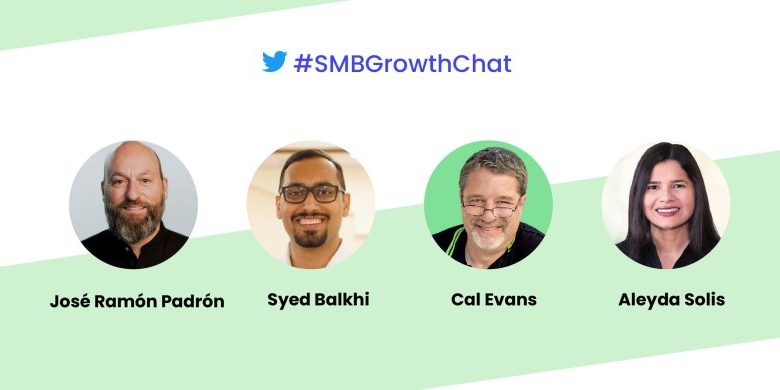Start, Grow & Succeed Online with Tips from Top Business Experts

Start, Grow & Succeed Online with Tips from Top Business Experts
Table of Contents
As a small business owner, you need to manage almost everything yourself – your brand, your store, your website, etc. To help navigate through all that, we’ve got you covered with professional advice from top experts that will help you start, grow, and succeed online.
We organized an #SMBGrowthChat on Twitter Spaces along with Syed Balkhi (@syedbalkhi), Entrepreneur, Investor & CEO, Cal Evans (@CalEvans), eCommerce expert & Internet entrepreneur, Aleyda Solis (@aleyda), International SEO Consultant & Entrepreneur, and José Ramón Padrón (@monchomad), SiteGround Spain Country Manager. Here’s a summary of their discussion with some expert tips on how to succeed online.
Essential steps when starting an online business
The very first essential step to starting an online business is knowing your target market. “In my mind, the most important thing for a business is knowing who your customers are and how you can get that customer,” notes Syed Balkhi, Entrepreneur, Investor & CEO.
As a next step, you need to come up with a domain name and website idea. Aleyda Solis, International SEO Consultant & Entrepreneur, points out that “the building block, the main pillar of your online business should be your website”.

Create your small business website
Now that you are at the stage of building your website, you need to choose carefully which website building app to use for your small business site. It will all depend on the functionalities you need in order to provide your services or products, as well as on your own capabilities.
For example, if you have technical capacity, you’d probably be able to develop your website from scratch. However, that would take you much time and effort. For this purpose, as a programmer, Cal Evans recommends using WordPress: “The reason I say that is because I’m a programmer, but I can spin up WordPress and put a theme in there and put together 5-6 plugins and usually get exactly what I’d have done, without having to program”. Syed Balkhi also recommends WordPress and points out that 43% of the web uses it, including SMBs, developers, entrepreneurs, and others.
Must-have elements on your website
After you’ve built your website, let’s explore what are some of the must-have elements to include on it.
No matter what type of website you have, you need to communicate what you do. Aleyda Solis points out that “you should have at least a landing page, explaining what you’re offering, what’s the value of it, its price (range), and a contact form, so people can get in touch with you.” She adds that if you have many products, categories, or brands, then you need proper navigation that allows users to go through your web structure and reach your different offerings. Of course, if your website is very complex, you need to add a search feature as well.
Syed Balkhi builds upon this idea and notes that you need to have a way to stay in touch with your users, to enhance their user experience and help them get to the goal of conversion (subscribing, buying, etc.). In his opinion, it’s good to “add an email newsletter, or a push notification platform, because you need a way to connect to your visitors after they leave (the majority of people leave your website and they never come back – it’s like 70% or for some websites it’s even 97%), or even SMS notification.”
A general rule to follow when adding these elements is that “the most important content should be no more than two clicks away,” José Ramón Padrón says. Think about the user experience and the importance of CTAs – make it clear and simple for your users to get the information they need with minimum clicks.

Scale your online business
“You can not improve what you can not measure,” points out Syed Balkhi. To scale your business, you need to know your visitors – how they are finding and using your website, because this helps you focus on the content and products that matter the most, he adds.

For this purpose, Aleyda Solis recommends using marketing analysis tools “to better assess which are the keywords that are already bringing traffic to your website from an organic search point and from paid search perspective as well.” Some of the most popular marketing analysis tools you can use are Google Analytics, MonsterInsights, SEMRush, etc.
As a next step for scaling your business, Aleyda Solis recommends using marketing automation tools: “such tools will allow you to easily follow up with your customers, if at some point they leave a landing page, before converting […], to collect and develop your audience with forms that you can easily create, similar to email marketing.” If you’ve chosen WordPress, there are many plugins that can provide this automation, as well as plenty of integrations with some of the top marketing automation platforms.
“When you already have a product and you know what’s working, now you have to do a lot of testing and optimization, so you can use a landing page builder that lets you do dynamic personalization – you can try different offers, different PPC ads,” adds Syed Balkhi.
When your business is growing, it’s also important to use a hosting provider that offers a variety of products in order to avoid further migrations. As José Ramón Padrón points out, “you need a hosting provider with many data centers, CDN points all over the world, specific tools for improving website security”.
Sometimes, when the business grows, the team also grows with it. For this reason, there is a need for automation of internal processes – how the information flows inside the company – tools like Jira, Slack, etc. are important, José Ramón Padrón adds.
Fundamental marketing channels
The number one channel to reach your customers is through search engines (the biggest ones being Google and YouTube), thus SEO would be your most important starting point. Aleyda Solis advises you to have an SEO specialist, when building your website in order for SEO practices to be taken into consideration right from the start, so that later on, when you’re ready to launch your full SEO strategy, it would be easy for you to do so.
“Keyword research within the SEO process is super valuable not only for SEO, but also to understand when you still don’t have internal data, how your audience is looking for your products or services, and how to position yourself versus your competitors,” Aleyda adds.
Your mailing list is the next important marketing channel – “it doesn’t need to be a full email marketing strategy at the beginning, but starting to collect email contacts right away is something I’d recommend,” notes Aleyda Solis. This will allow you to build an audience and engage with it later on in a more personal way.
After that, you canstart building your mailing list with people that are interested in what you might be selling or the services you offer, as noted by Cal Evans, eCommerce expert & Internet entrepreneur. He adds that once you know you’ve got a product market fit and a website, then you can register your Twitter, Instagram and other accounts, and start building your mailing list.

Syed Balkhi gives you a bonus tip for you to engage and connect with the audience you’ve built by now: “Push notifications work equally as good, if not better than email marketing, and that would be a less known tip that not many SMBs take advantage of”.
Growing your mailing list
Now that you have a mailing list with subscribers, you need to figure out a way to further grow this list. We’ve got you covered with actionable tips from our experts:
- Create compelling content
It’s easier to create compelling content than you think. “Look around for the questions that people ask you, and you can put together something like a pdf and build a landing page with it with OptinMonster,” explains Cal Evans.
- Run social media campaigns
Cal Evans also shares that to boost his subscription rates, he runs social media campaigns about once a month and it works for him. “You have to be careful – you can end up spending a lot of money and getting absolutely nothing, but you’ve got to figure out where your target market/audience is – are they on Twitter, Facebook, etc.,” adds Cal Evans.
- Implement exit intent
Exit intent is that thing you see when you start taking the mouse towards exiting the website – like a pop-up, for example. “Some people might think it’s really annoying, but the reality is that that user was going to leave. By showing them a good and targeted offer, it converts 2% of the users into subscribers,” Syed Balkhi points out.
- Add content upgrades
It’s also important to analyze where your traffic is going to and then add content upgrades to these pages, such as your most popular blog post, for instance. “In this blog post, create a lead magnet – an eBook, a chat list, a worksheet, etc. – a freebie that’s specific to that blog post. For example, you have 12 tips to get more traffic, and then 5 bonus tips that you’d only be able to get, if you subscribe,” Syed Balkhi explains.
Do this by adding a CTA at the top, middle/bottom of your page (or both places). When the user clicks that link, a pop-up comes up and they should enter their name and email to access that content upgrade, Syed Balkhi advises.
- Do on-site retargeting
You can always spend money on Google or Facebook retargeting ads, but there’s also a way to do on-site retargeting. If a user came to your website, then they left, and later on came back, there are ways to target that customer, using a plugin like OptinMonster, as Syed Balkhi points out. A simple message like “Welcome back! Consider joining our list, so you can get updates?” could do the trick.
- Run on-site follow-up campaigns
When somebody visits a specific page on your website, you can prepare a follow-up, especially for them. “Maybe they’re already a subscriber to your email list, and when they come back to a specific page, you can give them an exclusive discount or a coupon. Also, if you’re just starting out, you can use giveaways,” advises Syed Balkhi.
These are all great ways to boost conversions and get more subscribers. A general advice that applies to all of these tips is to be very natural with them and avoid an intrusive approach. They “can be embedded/integrated within the workflow that you have for your user journey, in a way that’s actually attractive and appealing to the user,” Aleyda Solis summarizes.
Final thoughts
In 2020, we saw a lot of new businesses starting online, and then disappearing in 2021 or 2022. To avoid having such a short business lifetime, follow our experts’ tips and make sure you define your target market, prepare a competition analysis, build a marketing strategy, and create a website with customer experience around the product or service you want to sell.
Check our YouTube recording to hear the whole Twitter chat conversation and follow us on Twitter for more news and discussions on useful topics.



